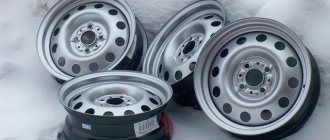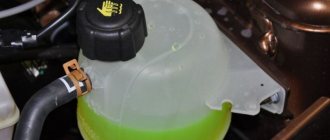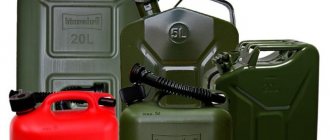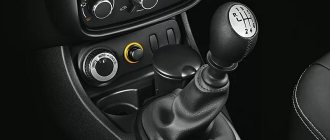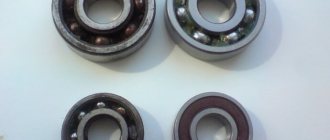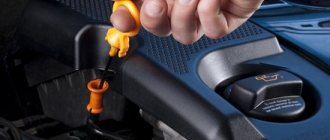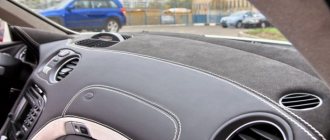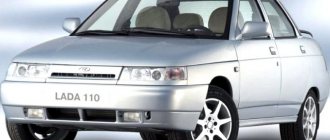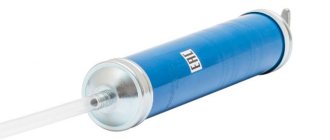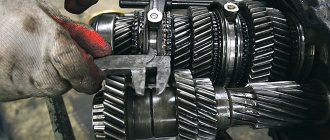During the operation of the car, its headlights gradually lose their original transparency and brightness. This spoils its presentability and reduces the lighting intensity, which can affect traffic safety. The natural question arises of how to get rid of this and return the original appearance of your pet car. The budget does not always allow for a car service, so here we will look at whether it is possible to polish headlights yourself. We'll show you how to do this with toothpaste and what mistakes to avoid when working at home.
Causes of cloudiness
The main factors that negatively affect the quality of plastic car windows are sand and microparticles that constantly “bombard” lighting devices while driving. And the more intensively the car is used, the higher the speed the driver uses, the faster the glass of regular and fog lights becomes cloudy. Microcracks form on their surface, which reduce transparency and light transmittance. Using a car in dirty conditions leads to microparticles of dirt getting into the cracks, which further leads to clouding of the glass.
In addition, cheap plastic, used in inexpensive cars as headlight glass, turns yellow over time under the influence of the natural environment (sun rays, reagents used in winter). More expensive models use a special ultraviolet coating for plastic headlight lenses, which is less susceptible to clouding under direct sunlight.
Causes of cloudiness
Yellow headlights, if this is not a special type of tuning, cause sympathetic glances from drivers and problems with traffic police inspectors. The requirements for the quality of road lighting are high, and if the lights have dimmed significantly, this is a direct violation of traffic regulations.
The cases are made of glass and plastic. Optics manufacturers refuse to use glass for many reasons:
- expensive;
- glass blocks are heavy;
- do not require frequent replacement and are not profitable to produce.
It takes more than one year for headlights made of glass to become cloudy. Plastic cases are 70% lighter and 560% softer than glass. It is beneficial for manufacturers to use plastic, because car owners have to spend more time and money on maintaining them. Reasons why optics units turned yellow or cloudy:
- Systematic impact of gravel, which hits the lights at speed.
- Using light bulbs of unspecified power: the protective coating in the plastic peels off from the inside.
- Dust accumulates in microscopic cracks.
- Overheating during polishing causes the plastic to become cloudy and dark.
If the lights have lost their transparency, you can restore the optics with varnish, after polishing the surface.
Recovery method No. 3
Restoration of headlight reflectors can also be done using mirror film. For such work, experts recommend using Oracal film - films No. 351 and No. 352 are perfect for the job. They are made on a polyester basis and guarantee good reflection and are not susceptible to moisture or mechanical damage. Provided that the film is in a sealed space (a properly installed headlight is sealed), such material can be used for years. After removing the headlight and cleaning the reflector, follow these steps:
- create a layout for cutting out a piece of film using tape. Cover the entire surface of the reflector with it, smooth it and cut off the excess parts;
- Based on the layout you have made, draw and cut out the required piece of film;
- stick the film strips using a hair dryer;
- smooth the film, removing air bubbles from under it and stretching the material along the edges of the reflector;
- Paint the corrugated surface of the reflector with chrome paint, which is sold in cans.
How to restore the transparency of headlights using varnish
Restoring headlights under varnish is an alternative way to return proper lighting to your car. The method is suitable for glass and plastic headlights only if the optics are not significant, more than 3 mm. into the depth of scratches and chips.
Before varnishing, it is necessary to remove the yellowness of the headlights by simple, non-machine polishing.
Restoring headlight lenses with significant scratches and chips requires machine grinding and polishing.
Before varnishing, it is necessary to drive the car into a garage, the air temperature is at least 20 ° C. You can remove the running lights from the car; in this case, you will not need to protect the body during polishing and varnishing. The whole work will take an hour and a half. The coating will dry for at least a day. During this time, you must not touch the surface, try to correct it, etc.
The restoration process step by step, if you do not want to remove the headlights:
- Use masking tape to cover the paintwork near the optics unit.
- Use 400 grit sandpaper to remove large scratches. You can clean it manually for 3-5 minutes.
- Using 1200 grit sandpaper, re-treat the surface. You can use a polishing machine.
- While cleaning, water the block generously. It is not recommended to use polishes: they are difficult to wash off.
- Clean the surface from dust and polish, if used with a hairdryer.
- Degrease the surface and dry thoroughly.
To restore transparency, either a two-component varnish or a special one in cylinders is used. Two-component, consisting of resin and solvent, pre-filtered. Apply to the surface via sprayer.
- Cover the car with film to prevent the varnish from damaging the bodywork.
- Spray a thin layer of varnish over the entire surface. Try to complete the procedure in one step, making the layer of varnish the same over the entire surface.
The composition will fill all cracks and roughness on the body, making the outer wall smooth. This will ensure optimal refraction of light through a uniform coating. The material will harden in 50-60 minutes and completely dry in 48 hours.
Types of automotive optics
Headlight glasses are an important element of the lighting system; auto prism can be made from:
- Glass;
- Polycarbonate;
- Acrylic (plexiglass).
Glass
Among the advantages: beautiful appearance, ideal light transmittance, long service life.
Glass has a number of disadvantages: with the slightest impact it can easily crack, and it is also easy to scratch.
For protection, a special film is glued to the surface of the headlights.
Polycarbonate
This optics is resistant to various types of mechanical damage, it is 200 times stronger than glass , and can withstand temperature changes well.
However, polycarbonate becomes cloudy during use, and it can also lose its quality characteristics under the influence of acid-containing products.
Plexiglas
Optics made of acrylic (plexiglass) are more practical. Acrylic and polycarbonate are similar materials, but compared to polycarbonate, plexiglass is more transparent, but with temperature changes, cracks and chips may appear on it.
Which varnish to choose
Depending on the surface material, the varnish for the headlights is also selected. For glass bodies, acrylic, two-component, polyurethane compounds are used; for plastic optics, only two-component, aerosol ones are used.
Purpose of coverage:
- tinting;
- protective.
The composition for restoring the capacity of a clouded headlight is marked according to the classification. When choosing an aerosol or two-component material, it is recommended to pay attention to the ratio of active substances. Drying time and shine depend on the amount of polymer compounds:
- UHS. The varnish contains less than 15% polymers. The material dries quickly and is often used as a tint or protective after polishing.
- H.S. More than 70% polymers. The material dries slowly and can be used to polish headlights and restore full transparency. It is recommended to apply in 1 layer.
- MS. Equal amount of polymers, solvent. The material is suitable for restoring throughput and for tinting. Apply in 2 layers and dry in 24 hours.
- The two-component composition is available in two containers: dry residue and solvent. Before work, it is necessary to mix the substances and filter the material through a sieve.
- Polyurethane is available in aerosol cans, completely ready for application to the surface.
- It is recommended to varnish the block with your own hands using aerosols. There is no need to mix components, calculate proportions, or look for a spray bottle.
Recovery method No. 4
This method of restoring a reflector is similar to the first method, but is a simplified version of it. If you don't have foil, tape or metallic film on hand, you can simply use paint with chrome chips, which can be purchased at any auto store.
Before applying paint, you must thoroughly wash and degrease the reflector. After this, apply a thin layer of paint and let it dry for several hours. Once the chrome has dried, the DIY reflector repair is complete and the headlight can be put back together.
Restoring a reflector using chrome paint for headlights
Restoring headlight reflectors is quite a technically complex task if you want to achieve a complete restoration of the mirror coating. Below we will list several ways in which you can update your headlight reflectors with your own hands, and you will choose which one is most suitable for you. We will briefly consider the most effective options at the end, but a detailed description of them would require a sufficient amount of space, and their use is not always justified at home, since it requires the manufacture of special equipment. If your plans do not include professionally restoring headlights , then purchasing or manufacturing equipment will lead to the fact that, as they say, “the game won’t be worth the candle.”
Ceramic varnish
Car enthusiasts who believe that the chemical composition of polycarbonate ceramic varnish contains elements of ceramics are mistaken. The material received its name due to the great similarity of the hardened varnish to natural ceramics. More often used for painting the body, it has up to hundreds of shades from matte to chameleon.
Ceramic varnish to restore the transparency of headlights is more often used in garage repairs. A transparent composition is selected that gives shine and gloss to the glass surface. Apply with a brush or spray.
Ceramic varnish “heals” microcracks and completely restores the surface due to its non-uniform hardness. The outer microlayer has increased hardness, the inner one is elastic. When a scratch occurs, the inner layer fills the crack, restoring the original appearance.
Before applying ceramic varnish, it is necessary to completely remove the factory varnish.
Why does the reflector fail?
Regardless of the type, the purpose of the reflectors is identical: to form a directed beam from the light of the lamp, which is emitted in all directions. To do this, the inner surface of the reflector must be perfectly mirror-like. However, over time, the mirror layer is destroyed. This is primarily due to physical wear and tear. Also, damage to the integrity of the coating can be caused by poor sealing, large temperature changes and liquid getting inside the headlight.
Destruction of the mirror layer often occurs when installing lamps whose power significantly exceeds the calculated value set by the optics manufacturer. In this case, the coating simply fades over time.
Polyurethane varnish
One of the most common types of protective chemicals for automotive optics. It consists of a solvent and a varnish base mixed in different proportions.
It is necessary to restore the optics and remove yellowness only after polishing the headlight, washing and drying it. The quality of the brightness of the optics and the durability of the coating depend on the adhesion strength of the surface and the varnish composition.
Polyurethane varnishes are equally suitable for restoring plastic and glass cases. If the interior of the polycarbonate headlight peels off and the optics become cloudy, replacement is recommended. It will no longer be possible to restore the quality of light output.
Repair of car headlight housings and glasses
The housing of headlights or lanterns is repaired by welding with hot air injection. For these purposes, a special soldering iron is used, which is “powered” by compressor air. Using a hair dryer, the pieces of the body are returned to their place and attached. It's common to repair cracked or broken headlights, so the pieces may not be enough. In this case, spare parts for headlights that have been repaired before will come in handy.
The seam should be welded both from the outside and from the inside in order to provide the headlights with the required strength. Before you begin work, you should find out what kind of plastic the case was made of. It could be ABC plastic or polypropylene. If it is ABC plastic, then it can be repaired using the “cold welding” method, but polypropylene can only be welded
Please also note that these materials cannot be combined! If you weld one to the other, you will get a very weak connection
It happens that the glass in the headlight is completely destroyed, and it is not possible to replace it with a new one. In this case, plexiglass comes to the rescue. Before starting this work, it is necessary to reproduce the shape of the damaged glass. The lost parts at this stage are replaced by plasticine. As a result, you should have a template form on your table. This is what the gypsum matrix is made from. Then you should cut a piece of plexiglass to the desired size. Typically, a headlight requires transparent glass up to 6 mm thick, and for sidelights or fog lights - no more than 5 mm.
Next, you need to take tracing paper and draw the internal pattern of the old glass. To measure everything very accurately, use a caliper. Taking a template, the design is reproduced on plexiglass using a milling machine. This allows you to maintain the luminous flux almost at the same level and achieve minimal error.
After these steps, both the gypsum matrix and plexiglass are packaged in a vacuum heat-resistant bag. The next stage will cause difficulties for many, but it only seems so. You should find a special machine or workshop where you will be allowed to use this device to heat the envelope until the plexiglass softens. At the same time, the compressor helps create a vacuum in the glass. As a result, the pressure of the outside air gives the glass the shape of plaster. Please note that these steps only help to make the front part of the headlight, but the “sides” are made separately and attached later.
Application process
Glass running lights that have lost their transparency are often processed only on the outside. Glass, as one of the hardest materials, is practically not subject to clouding due to a burnt-out light bulb in the unit or a short circuit. The external varnish coating of the headlights is made from a spray can.
In the case of plastic blocks, there is a possibility that the outer surface is damaged by scratches, and the inner surface begins to peel off due to frequent overheating. In this case, the optics are dismantled from the car, internal and external restoration and polishing are carried out.
Grinding, coating the plastic of rear lights, dimensions, head lighting in steps:
- Dismantle the headlights, remove the lamps and blocks from the housing.
- Separate the plastic part by preheating it with a hairdryer.
- Wash the headlight.
- Sand the outer and inner surfaces.
- Wash and dry the block.
- Degrease the surface.
- Treat the outer and inner surfaces with an activator.
Polishing
This method of exposure is considered more effective for plastic car headlights, but in addition to masking tape and sandpaper, it requires a machine with a special attachment and polishing paste.
Motorists select any abrasive product that is suitable not only for repairing headlights, but also for removing scratches on paint. It is not necessary to buy a polishing machine; sometimes the device is rented or replaced with a screwdriver.
The drill is not suitable due to high speeds; it can damage the coating. A polishing wheel is purchased separately; it is fixed like a regular drill. Inexperienced car enthusiasts are advised to use medium-hard nozzles.
Using special wipes
Wipes for restoring headlights can only be used as an aid. They will quickly restore only slightly tarnished glass or plastic. Before use, it is also necessary to treat the surface with fine-grained sandpaper (from 1800 grit). Cleansing takes no more than a minute.
The manufacturer recommends washing and drying the headlight before using the wipes. Experienced drivers prefer to additionally sand the surface with sandpaper of more than 2000 grit, or pre-polish with toothpaste.
It is necessary to wipe the cleaned and dry headlight with a special cloth without rubbing the varnish. Apply the product with gloves. The DOVLight coating lasts on the headlight for up to 7 months.
Restoring headlight reflectors using vacuum coating
Headlight reflectors before and after pneumatic spraying
This method makes it possible to restore the mirror coating of headlight reflectors , and it will not be inferior to the factory one. It consists of depositing metal particles in a vacuum chamber. A vacuum is needed to prevent the oxidation of microparticles of the metal evaporated by heating.
It is not always possible to create the necessary conditions for restoring a headlight reflector in a vacuum chamber.
The difficulty lies in creating a vacuum chamber equipped with an observation window to monitor the process. Craftsmen use glass containers for this purpose. In addition to the camera itself, you will also need a vacuum pump. No less difficult is how to ensure heating of the metal. The most acceptable, although unsafe, is to use a magnetron from a microwave oven (“microwave”) for this purpose. But those car enthusiasts who have managed to solve these problems are very pleased with the results - the coating of the headlight reflectors is almost as good as the original one from the very first attempts.
Not only tires or a car engine are subject to wear, but all its parts in general. This is especially true for external systems that endure the corrosive effects of temperature changes, wind, and crushed stone flying from the road.
Other means
Glass housings can be cleaned of plaque through steam restoration of headlights. The ribbed surface inside is quickly cleaned of yellowness and dust. The outer surface is polished and varnished.
You can restore the original shine of the optics by chemically restoring the headlight. Meguir's set will do. The kit includes:
- headlight cleaner;
- degreaser;
- varnish cloth.
There is no need to grind the optics: the cleaner will remove all dirt, and the polyurethane varnish will quickly fill microcracks.
Reflector repair
You can implement three main methods with your own hands. Their effectiveness has been tested by time and the experience of many motorists.
The general condition is to disassemble the headlight into its main components, otherwise there will be no access to the reflector.
The sealant is destroyed under the influence of high, artificially created temperatures at home. The headlight is placed in the oven for a third of an hour at a temperature of 75 degrees.
After the procedure, the parts must be cleaned of excess substances, especially those obtained through contact with the oven. Then you can proceed to the main stage.
First option
To complete the repair you will need cans of white lame paint.
This is the simplest method in which chrome plating of a damaged element is carried out.
Interesting! Before applying paint, the reflector must be degreased for better adhesion of the applied coating. After washing, drying is carried out, because water also reduces adhesion and evenness of application.
The simplest use of the spray can allows the painting itself to take only a few minutes, and the next step is to install the reflector back into the headlight. Don't forget to let the paint dry. This completes the restoration of the reflector.
Second option
The principle is the same as in the previous method, but the quality of the resulting coating is higher.
Here you will need:
- metallized tape, resistant to temperature changes and durable;
- chromium.
Despite the larger amount of materials, the method does not require adhesive materials, because the tape itself performs a connecting function.
Algorithm of actions:
- Measure and cut pieces of tape to fit the shape of the reflector.
- Stick them to the corresponding parts of the headlights, having previously degreased the parts.
- Cover parts that cannot be covered with chrome.
Third option
Advanced option. You will need:
- chrome in a can;
- mirror film;
- construction hair dryer;
- thick tape.
After the general steps of disassembling the headlight and degreasing the parts, the film is attached. A mock-up of the required parts is first created: the tape is glued to parts of the reflector, and after determining the required dimensions, it is removed.
A film is cut out according to its shape and connected to the cleaned surface. Adhesion occurs using a hair dryer: the film is glued when heated. After a hairdryer, it is pulled over the edges of the headlight and smoothed out.
Important! Make sure there are no air bubbles. As in the previous case, the remaining parts are coated with chrome.
Restoring the headlight reflector with your own hands turned out to be not such an impossible task. Moreover, the algorithm for each method is simple and can be done by anyone.
If you are still concerned about the final quality, you can entrust the repair to specialists, but remember: this will entail losses and difficulties.
How to clean headlights with toothpaste
You can restore the original appearance of a glass or plastic case with toothpaste. If the clouding of the optics unit is associated with peeling of the polycarbonate layer inside the plastic headlight, no method of external cleaning of the housing will help.
To clean headlights with toothpaste in no more than 30 minutes, you will need:
- any paste with a whitening effect;
- polishing machine with a soft felt nozzle;
- pure water;
- degreaser;
- rags for wiping.
Cleaning process in stages:
- Wash the headlights and wipe dry.
- Treat with a degreaser.
- Apply the paste directly to the body or to the surface of the sponge of the polishing machine.
- Thoroughly clean the surface with the paste for 3–5 minutes if using a machine, 12–15 minutes if cleaning by hand.
- Rinse off the paste with clean water and wipe dry.
After cleaning with toothpaste, they pass over the surface with special varnish wipes. Applying the varnish takes a few minutes, and the optics restore their original shine and brightness.
Cover the headlights around the perimeter
Why put tape around headlights?
In a minute you will start sanding. It is important that you only sand the lenses and not strip the surrounding paint or damage other parts of the car. Therefore, use tape to completely cover the working surface of the headlight and protect the rest of the car. Even if you are a very careful person, the sandpaper can still slip off, and hello – scuff marks on the paint.
Manufacturers
The Delta Kits company produces single varnishing kits. The set includes:
- two-component varnish;
- degreaser:
- polishing paper in calibration 320,500,800,1200,1500,3000 grit.
- felt lint-free napkin.
With one set you can polish your optics yourself and apply Delta Kits varnish. Its main advantage is the protection of plastic from UV, maintaining the transparency of the restored headlight for up to 22 months.
The manufacturer Dovlight produces kits for restoring car optics, two-part and aerosol varnishes, headlight cleaners, and anti-rain. Polyurethane varnishes are characterized by a small percentage of solids, dry quickly, hardening occurs in 20 minutes, complete drying in 24 hours. Restores initial light penetration by 98%. Well-known manufacturers:
- Diamond Vision;
- Meguir's;
- Philips Headlight;
- Presto.
The degree of wear of the block affects the choice of reducing agent. Depending on the number of scratches and chips, the restoration option will depend: napkins without sanding, light sanding, polishing or serious restoration.
Why does moisture appear inside the car optics?
First, let's look at the design of modern head lighting. The headlights of the car are a single body with polycarbonate glass glued in with sealant. Inside there are reflectors, diffusers, and an adjustment mechanism.
Moisture affects all components of the optics
There are options with built-in lenses, including for gas-discharge lamps. In the case of standard xenon, there may be electronics inside the housing: control units and high-voltage lamp ignition units.
Contrary to the statements of some “experts,” the headlight housing is not sealed. The holes for installing lamps and bushings for electrical wiring are sealed with silicone or rubber gaskets. But when the lamp heats up, the air inside the housing expands and requires a hole to escape. For this purpose, any modern headlight is equipped with ventilation valves-breathers. They are located in strictly designated places, provide normal ventilation and are protected from accidental ingress of moisture.
It is better to disassemble lensed headlights according to the manual
Important! If the headlights are sweaty inside and condensation is forming, first check the breathers
- Ventilation holes clogged with dirt or blocked by the owner. Due to the temperature difference, condensation forms inside the case, and there is no ventilation.
- Cracks in glass or case. Unusual openings lead to direct water ingress and disrupt natural air circulation.
- Poor quality glass sealing after disassembling/assembling the headlight. For example, after unprofessional tuning.
- Fogging of headlights usually occurs during rain, car washing or at low air temperatures. In the first two cases, water enters directly through the damage; in the latter, condensation forms.
Condensation can accumulate both outside and inside
Fighting headlight fogging and repairing the entire car lighting system
Moisture getting under the plastic leads to such unpleasant and even potentially dangerous consequences as:
- deterioration of light output, decrease in lamp brightness, reduction in lighting range;
- accelerated corrosion of the reflector (in this case, only replacing it will help, so it is much more practical to eliminate fogging of the headlights in advance);
- intense oxidation of contacts, damage to electrical equipment;
- premature burnout of light bulbs.
Technicians do everything to eliminate fogging of headlights
. Maintenance begins with dismantling the bumper and depressurizing the lighting fixture. After inspecting the part, specialists perform the following types of work:
Dichloroethane is a toxic and poisonous substance. Therefore, beware of getting it on the skin of your hands, ensure a flow of fresh air into the room, work only with gloves and, preferably, glasses.
Repair with epoxy glue
Epoxy glue also glues headlight fragments well and fills voids well. The glue consists of two components: in one bottle there is epoxy resin, in the other there is a hardener. When these two components are mixed, a viscous consistency is formed, which when dried is a very strong composition.
Using epoxy resin is no different from using dichloroethane glue: cleaning and treating the surface of the headlight, gluing the fragments by applying glue to the joints and chips. After drying, the glued headlight is carefully processed with a grinding machine using sandpaper of varying degrees of grit.
Soldering damaged headlights
A damaged autoprism can be repaired by soldering with a technical hair dryer. Cracks or joints of collected fragments are heated until they are completely glued. After gluing, the surface is also sanded.
Replacing headlight glasses
If the headlight cannot be repaired, you will have to buy a new one. Installation is carried out only with fresh sealant after removing the old one.
